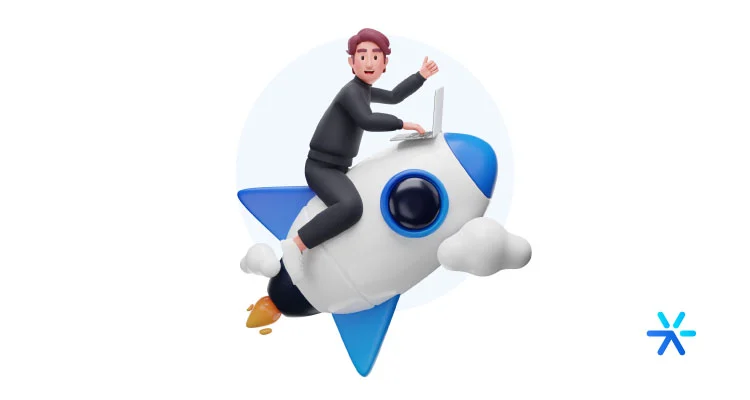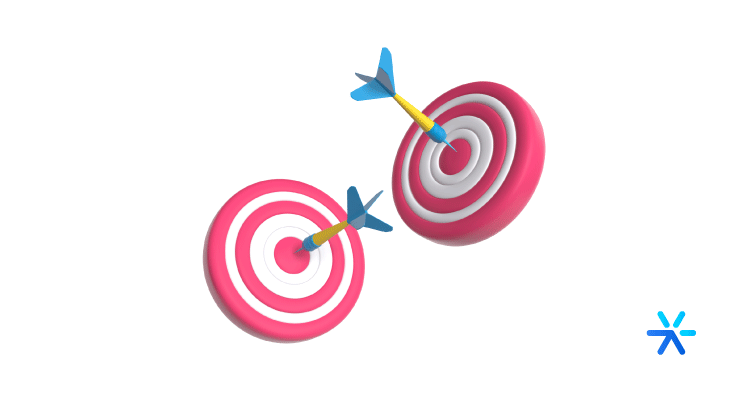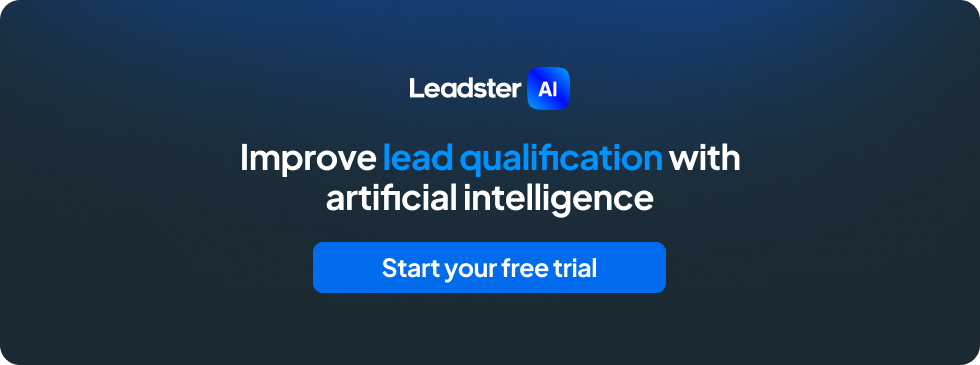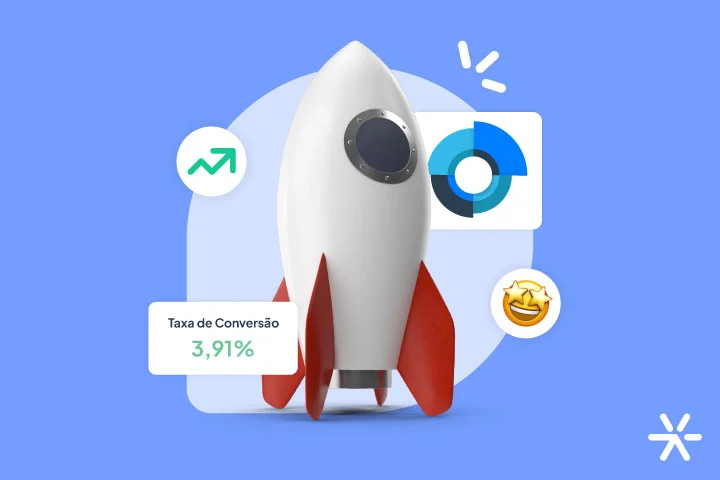The 13 best KPIs for a digital marketing agency
Do you have a list of the main KPIs for a digital agency’s goals? As of today, you do. 🌝
All efforts of a digital agency are very well calculated. Managing your resources to maximize profits is crucial in this type of business.
And like any good business, digital agencies also need the basics: growing with more clients and diversifying their services as much as possible to continually increase profits.
These are some goals of a digital agency, but the main one is efficiency. A leaner operation means more profits and faster decision-making, and of course: less stress.
Today we will show you the 13 main KPIs for a digital agency’s goals. But first, a definition:
What are KPIs?

Key performance indicators, or KPIs, are metrics that quantify very important information about the health, profitability, and efficiency of your business.
KPIs are a combination of the data every company has with an extra dimension of interpreting that data.
An example: you know how many clients you gained and how many you lost in a year – those are the data.
But there is a KPI that relates the two: by dividing one by the other, you get the churn rate indicator – your customer retention rate.
This is the main appeal of KPIs and the biggest reason for their popularity in companies. They are versatile, can be applied to any department for any goal, and despite being based on data, they bring some interpretation to avoid mistakes.
What is the difference between a KPI and a goal?
The fundamental difference between a KPI and a goal lies in intentionality. The goal is an objective, while the KPI is an interpretation of the current situation.
Through KPIs, however, it is possible to know how far you are from achieving a goal. Let’s see a practical example:
My goal is to reach 20 simultaneous clients generating a net profit of R$50,000 per month in my digital agency.
Notice the objective nature of the goal: it sets a path for the future but does not provide ready-made data or interpretations yet.
Throughout the year, I need to know where I stand in achieving this goal, right? That’s where KPIs come in. When I designed the goal, I set some KPIs that will serve as checkpoints – how close am I to hitting the goal?
Some of these KPIs can be:
- Retention rate: how many clients am I managing to keep per month?
- Cost per acquisition: am I making a profit or loss with each new client?
- Lifetime value: how much are my clients worth over their lifetime?
- Leads generated per period: how is the health of my new sales opportunities department?
Notice that these KPIs for a digital agency’s goals won’t tell you if you met your goal or not. KPIs do not give a final verdict. They show you your progress.
All this will become clearer as we discuss the KPIs themselves. Shall we look at some examples?
The 13 main KPIs for a digital agency’s goals

Now that we understand what they are, I brought a list of the 13 main KPIs for a digital agency’s goals for us to discuss a little more.
But just remembering that these are very general KPIs, which are normally used by other digital marketing agencies.
If you are a beginner in the field, I highly recommend reading some resources we have here on the blog. They will help you understand some of the more technical terms. See:
➡️ Marketing Types: 39 Strategies for Your Company
➡️ The 20 Best Marketing Techniques – that will actually help you attract more customers
➡️ Digital Marketing Strategies 2024: the Old and the New
These three articles will give you a greater understanding of the world of digital marketing agencies, if you need it.
Ready to start the list of KPIs for a digital agency’s goals?
Organic traffic growth
Let’s start with a simple KPI, but one that requires close monitoring, as it impacts several others and your overall lead generation.
Digital agencies always need to generate new leads. This is the most conducive way to find clients in a scalable and predictable manner.
And the most efficient (although more laborious) way to generate these leads is with organic traffic.
Organic traffic is nothing more than the number of people who come to your site without clicking on ads.
It is usually done through SEO-optimized blogs, social media posts, YouTube videos, and all general content marketing.
This KPI is comparative. You need to access Google Analytics and compare your results over a period. Some interesting parameters:
- Always analyze month by month. It is a more stable period with fewer random variations;
- Compare this month with the same month last year. Example: February 2023 with February 2022;
- Compare different periods to deal with seasonality. Example: February 2023 with September 2023;
- See which articles are performing better, and how much they contribute to your current results.
ROAS
The opposite of organic traffic is ads on paid media platforms, such as Google Ads, Meta, TikTok Ads, etc.
As the name indicates, these ads are paid – you set an amount for the monthly spend and pay per click.
But in the case of Google Ads, ad prices vary. In the search network, a mode that displays your ads on Google, each keyword for creating your ads has a different price.
On social media, although you pay for the reach of your ads, you also need to keep an eye on the return on investment – your ROAS, or return on ad spend.
With very low ROAS, all these actions are not giving you a very profitable return.
Measuring it is simple: add up everything you spent on a campaign and then subtract what you got in return. The KPI will show you whether your actions were worthwhile.

Cost per click
Still on returns in paid media, CPC is one of the most fundamental and basic metrics of any Ads strategy.
In fact, “CPC” is one of the synonyms for paid media, along with performance marketing.
Basically, you need to always keep an eye on how much you are spending on each click on your ads and relate this information to the goals of those ads.
For example: I run a campaign on Google Ads for the keyword “KPIs for agencies,” and the ad brings the reader to read this article.
Let’s assume I am spending R$3.50 for each click on the ad. Is it worth it? Is it worth spending more than three reais on an ad that leads to a blog post?
This KPI is measured with the help of others, such as the number of leads, cost per lead, and cost per acquisition. Thus, you can see the commercial value of your ads more clearly.
Leads generated per period
As we mentioned, a lead generation strategy is fundamental for digital agencies.
In fact, lead generation is the most basic point of any digital marketing strategy, especially those based on inbound marketing.
This KPI is more to the point – how many leads are you generating in a given period? And when you compare periods, are you noticing an evolution?
Lead generation is one of the main KPIs for a digital agency’s goals. It should be analyzed from two perspectives: top-of-funnel and bottom-of-funnel.
The number of leads generated for the top of the funnel determines that your efforts to bring more contact with your content – whether via organic or paid media – are paying off.
And for the bottom of the funnel, the number of leads is important information for sales KPIs. If these indicators are not good, your first question should be, “Am I generating enough leads?”
Conversion rate
The conversion rate is a multifaceted KPI: we could be talking about the conversion rate of visitors to leads, or leads to MQL, or MQL to SQL, or SQL to sales…
Any advancement in the marketing and sales funnel is understood as a conversion in digital marketing.
This is one of the KPIs for a digital agency’s goals that helps explain others. The previous KPI, lead generation, for example: if the number of leads is low, it may not be due to a lack of traffic on your site, but a low conversion rate of visitors to leads.
CPA – cost per acquisition
The cost per acquisition is almost like ROI, but it is such a general KPI that the ROI calculation encounters some difficulties.
Here, instead of analyzing by channel – e.g., paid media – you are analyzing how much acquiring each client costs you in total, regardless of where they came from.
This KPI is important because digital agencies tend to have lower monthly fees. If the cost of acquiring a client is very high, you are failing to profit from them.
This difference in profit can even turn into a loss eventually.
To calculate, add up all your marketing expenses over a period, and then divide by the number of clients you had.
Cost per lead
Still on costs: many agencies, in their quest to generate many leads, end up investing more than they can afford to generate them.
Leads are very important, but we must not forget that they exist to close sales, but they are not yet closed sales.
Your lead generation strategies should always prioritize the lowest possible cost per lead without hindering your generation.
Thus, you have more budget space for lead qualification.
And speaking of that:
Number of MQLs
We started talking about MQL in one of the above topics, but it is worth elaborating a little more to address this very important KPI for a digital agency.
MQL stands for marketing qualified lead. Generating MQLs is the goal of the middle of the funnel, concerned with lead nurturing.
The number of MQLs you generate is directly related to your sales. Within an inbound strategy, a qualified lead is ready to move on to the sales stage.
This is usually the last stage of marketing actions before passing the baton to the sales team.
Cost per MQL
It is also very important to measure the cost per MQL to avoid overexerting your efforts in lead qualification.
Always seek a commercial attitude. Generating MQLs is important, but if you spend more than planned, it becomes difficult to keep the entire sales process profitable.
There are other areas where it is more worthwhile to spend. Lead generation itself is more expensive than qualification.
Among the KPIs for a digital agency’s goals, those related to cost are the most important. In the end, you are playing a numbers game: spending less to sell more.
Number of SQLs
The bottom of the sales funnel has two main concerns: generating SQLs and generating sales.
SQL stands for sales qualified leads, which means leads qualified by the sales team and are the closest step to a sale.
The number of SQLs should be measured according to the number of MQLs. How many sales-qualified leads are you generating from the marketing-qualified leads?
This KPI will demonstrate where your main sales bottlenecks are. If sales are not happening, knowing this index will show one of the probable reasons.
SQL and MQL Conversion Rate
One last specific KPI for what we are discussing here: what is the conversion rate of your MQLs and SQLs?
Or, in other words: how often do your leads turn into MQLs, and how often do these MQLs become SQLs?
This metric is similar to the ones we showed in the last two topics, but it brings a slightly higher level of interpretation.
Understanding this conversion rate gives you a view of your specific efforts in this crucial conversion. Instead of just counting the number of MQLs and SQLs, you understand how your efforts are transforming them.
This KPI for a digital agency’s goal shows the health of your sales funnel where it is most needed: when it gets close to a transaction.
Churn Rate – Retention Rate
Off the top of your head, can you say what the average rate of clients staying with you after a certain period is?
Most agencies do not know, and this is dangerous. Understanding your retention rate provides predictability in your finances and indicates important improvements that have direct impacts on your profit.
This is a very important KPI for digital agencies to calculate. Simply divide the number of clients entering by the number of clients leaving within a determined period.
New Contracts
A very important metric that will crown all your efforts up to this point. Among all these analyses, the number of new contracts and clients is what matters most to you.
This is a KPI that you always need to measure, no matter what type of marketing you practice or if you are measuring all these other KPIs for a digital agency’s goals.
But always analyze comparatively. How am I doing today compared to last month? And compared to last year?
What tools to use to gather this information?

To finish the article, we need to talk a little about where this data comes from. How do you capture it to make KPIs for a digital agency’s goals worthwhile?
Well, there are platforms that aggregate practically all of this data. But you will need to work with more than one to have all of them really at your fingertips.
Beginner digital agencies usually rely on one or two of these platforms. One of them is free, while the others will require an investment.
Let’s find out which tools help you capture the necessary data to form your KPIs.
Lead Generation Platforms
Anyone looking to do a comprehensive analysis of generated leads and their different levels of qualification will need a platform that captures and organizes the leads.
Leadster is one such tool. In addition to a chatbot that increases conversion by up to 3 times, it also organizes and distributes your leads in a very understandable and simple way.
HubSpot is a platform dedicated to inbound marketing for capturing, organizing, and nurturing your leads. It is the most popular in the market, also offering the possibility to create your landing pages, analyze your traffic, and control your sales.
Google Analytics
Google Analytics is the free platform that allows you to track all the information about visitors to your website. It is essential for monitoring the development of your organic traffic.
Other platforms do a similar job: SemRush, Ahrefs, and SimilarWeb offer this data and some others.
But for this tracking, Google Analytics is the best possible tool, and it is still free. These other brands offer statistics that do not consider Analytics, offering estimated data according to the number of keyword searches.
Google Ads
Google Ads provides all the statistics you need to measure your KPIs related to paid media.
Through its dashboard, you can monitor the performance of your campaigns, how much it is spending, variation in cost per click, etc.
BI Platforms
Lastly, there are several BI – or business intelligence – platforms that capture a lot of data and offer extensive reports on each department of your agency.
These platforms, however, are more suitable for large companies that have a large volume of data to organize to create their KPIs.
The most popular platform is Microsoft’s Power BI. Visit the website to see if you need to use it. 😉
So, are you ready to start capturing your KPIs for a digital agency’s goals?
I hope so. But I have one last recommendation to make your advertising process more efficient.
As we mentioned paid media throughout the article, I think you will benefit greatly from a planning framework for your campaigns.
We’ve mentioned Leadster throughout the article, are you ready to start a free trial today? It’s free! All you have to do is click on this link.
Thanks for reading and see you on the next article!








